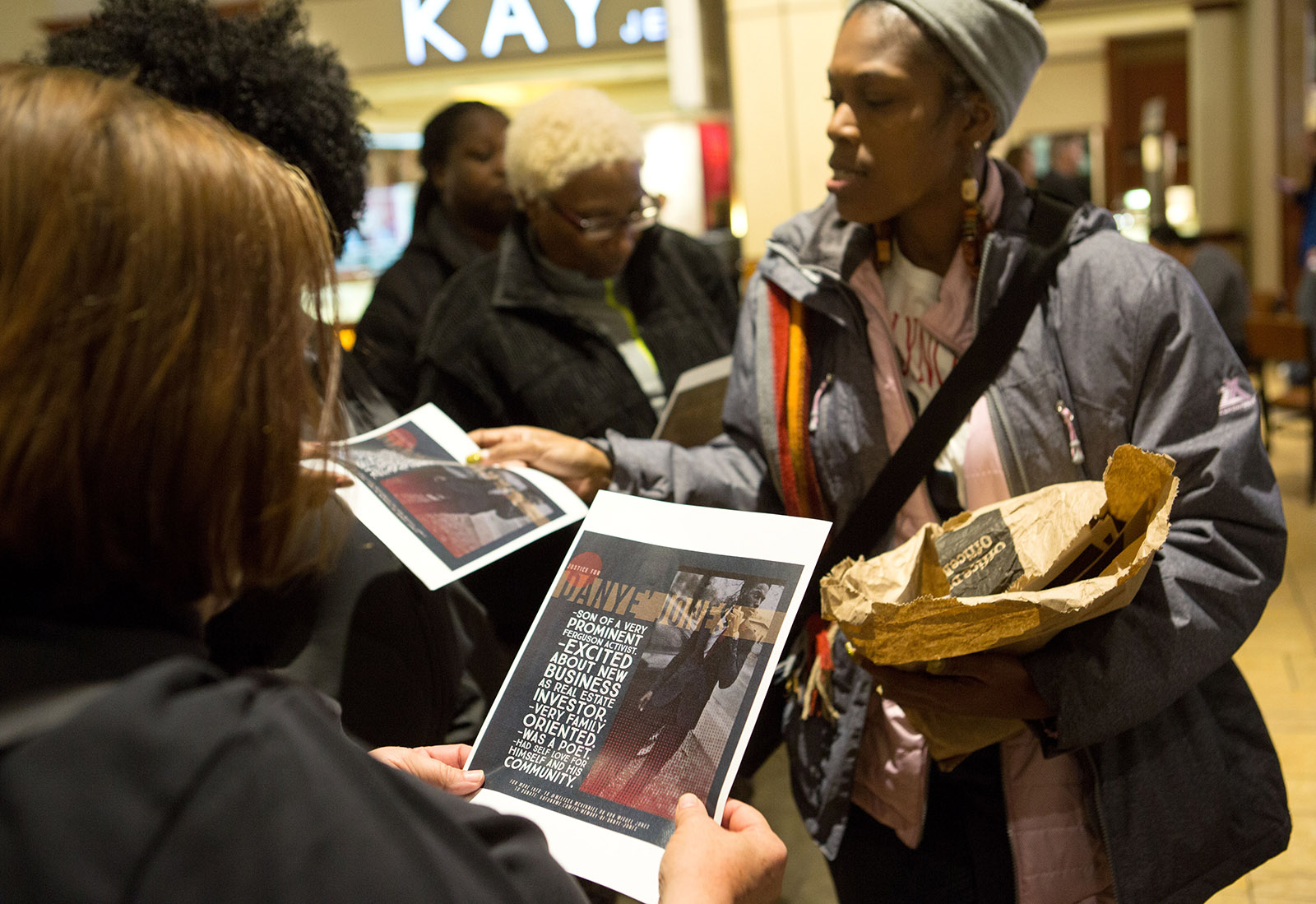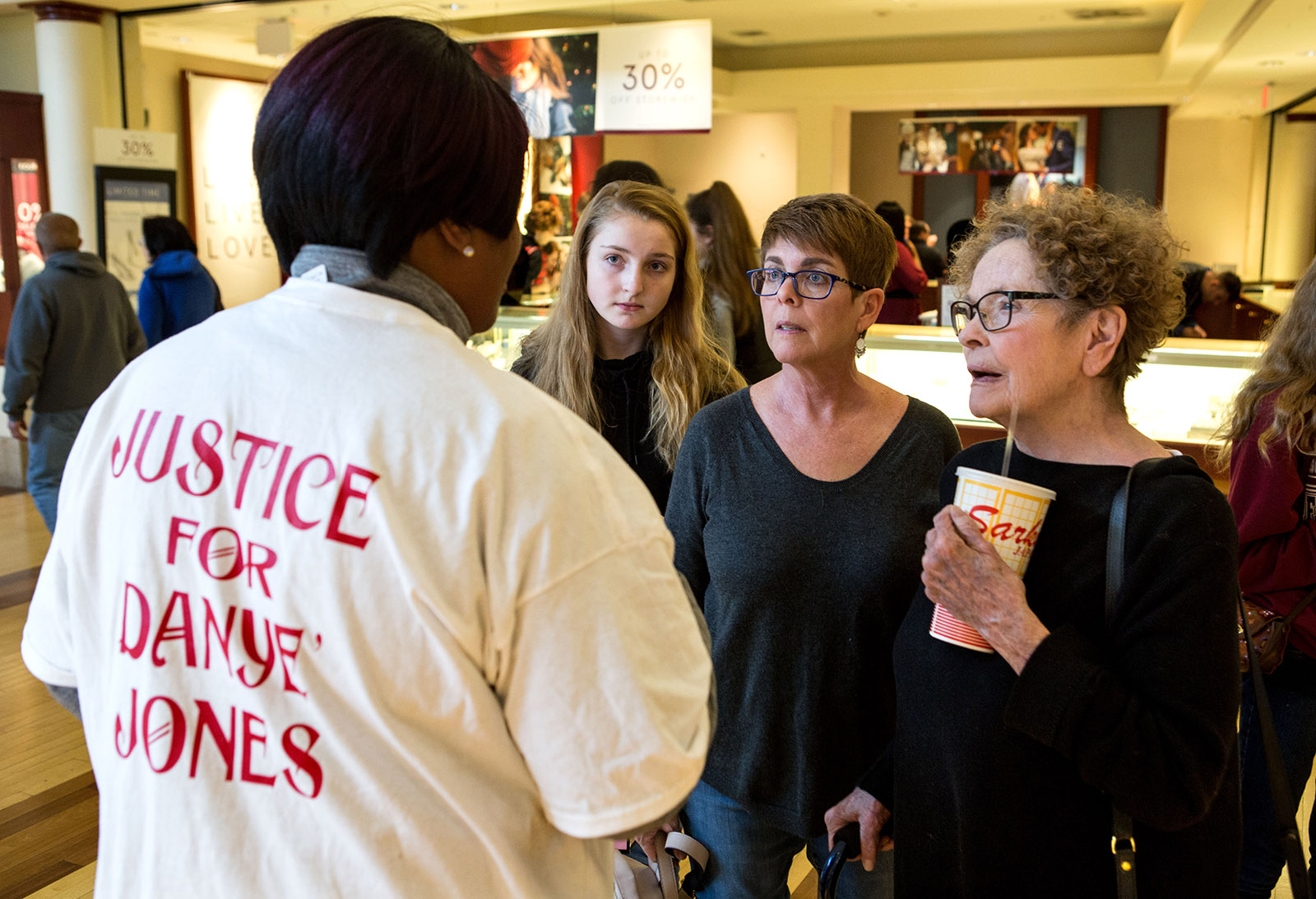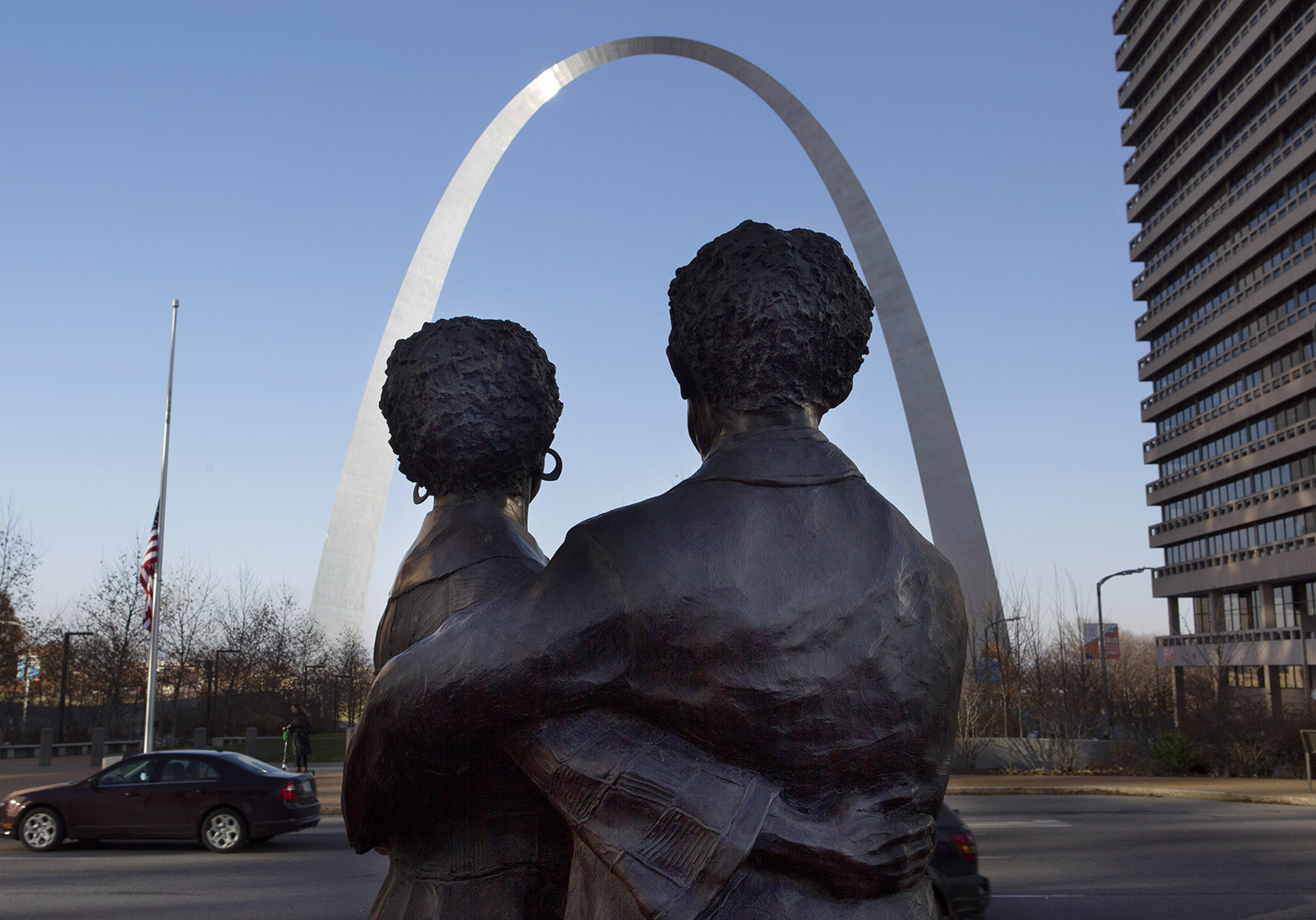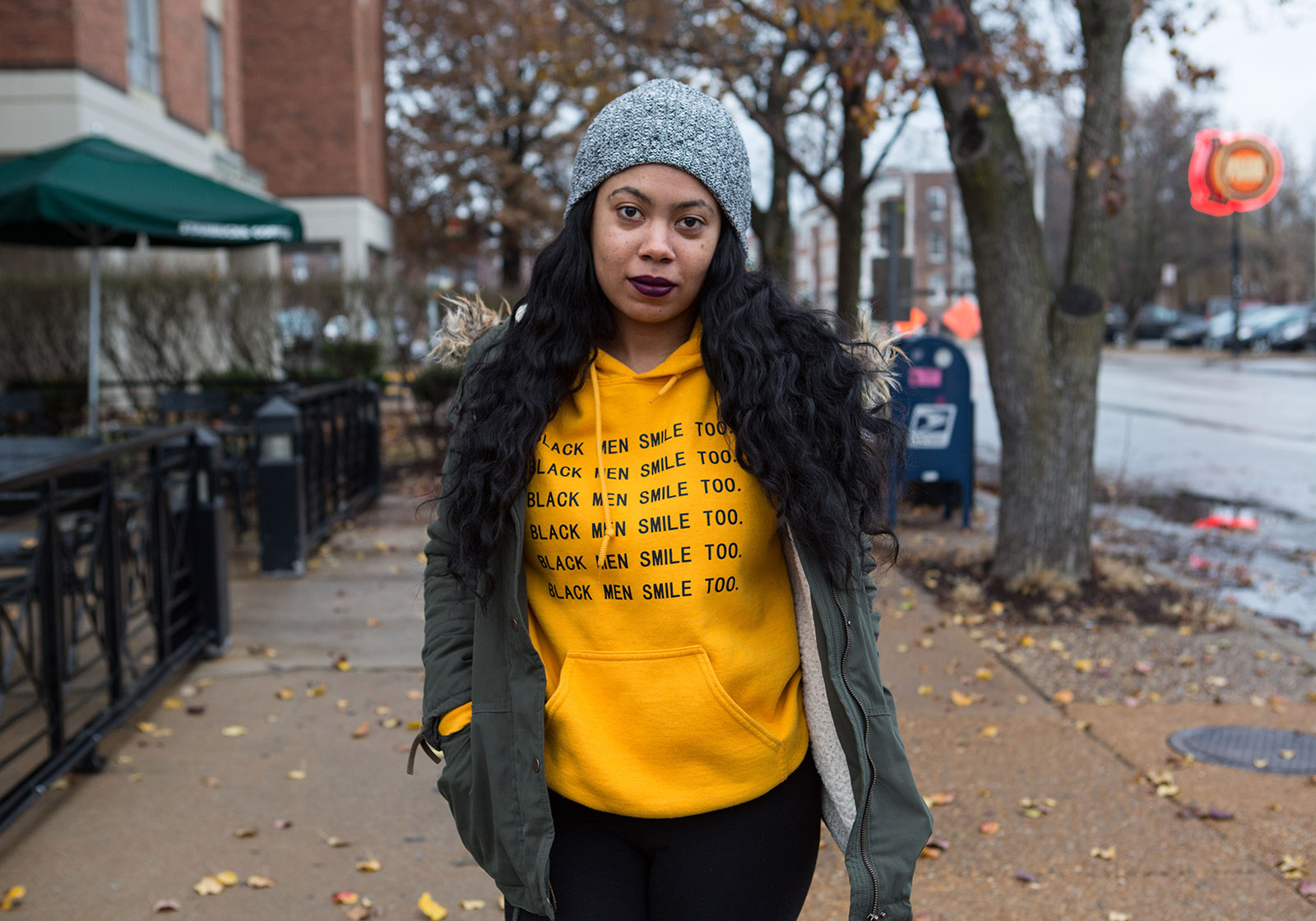St. Louis, Missouri—Ferguson activist Melissa Mckinnies sat on her couch, her hair tied in a bun, and spoke deliberately, in a soft, hushed tone. The shades were drawn.
On October 17, Mckinnies had woken to a terrible event. Early in the morning, when her husband, Derek, came home from his nightshift, he and Melissa noticed that her eldest son, twenty-four-year-old Danye, had left the light on in his basement bedroom. When they went to check on him, Danye was nowhere to be seen. Panicked, Mckinnies and her husband, Derek, searched the house and found a packed bag on the back porch, as if he had been preparing to go somewhere. Then she looked into the backyard, and there she found her son hanging by a sheet from a tree, mucus from his nose and mouth on his face.
The 911 operator said to take the body down from the tree, Melissa recounted. But before Derek and her brother Daniel, who also lives with her, untied the intricate knots on a sheet, Daniel took pictures of the body, using a flash because it was still dark, she said. The police came and ruled the death a suicide because there were no signs of trauma, according to the medical investigator’s report (St. Louis County police spokesman Shawn McGuire clarified that the incident is classified as a suicide but the investigation is still open). But Melissa was perturbed by details like Danye’s pants pulled down to his ankles and the fact that she believed Danye would not have killed himself. She posted the pictures of Danye hanging on Facebook, with the message “They lynched my baby.”
Danye Jones’s death occurred against a background of severe distrust between local activists and law enforcement, and the pictures went viral on social media. Some users posted them as proof of a white supremacist plot to kill Ferguson protesters. A GoFundMe was set up for Danye’s family to pay for their funeral expenses, a private investigator, and an independent autopsy, and has received more than $49,000 in donations.
The recently released medical examiner’s report, however, concluded that the cause of Danye’s death was suicide. No autopsy was done on the body, and a toxicology report showed nothing unusual. According to the report, family members told the medico-legal investigator, Michael Tarticchio, that Danye “had stated several times over the years that he felt depressed”; he “recently started a real estate business, which did not succeed, and he was dealing with rumors of him being a homosexual.” There was no trauma to Danye’s body other than the neck, according to the report, which also stated that the last time anyone heard from Danye was when he sent a text message to his sister Melisha at 9:30 PM the previous night saying, “I’m sorry,” to which she responded, “I love you.”
Some activists distrust the medical examiner’s office because it failed to photograph Michael Brown’s body in August 2014 (the examiner of that case told a grand jury, “my battery in my camera died”). Mckinnies dismissed the report’s account of her son’s death as lies, saying that he had just started his business and was feeling confident about it, that he was not depressed or worried about rumors of his sexuality, and that there was a “knot on his face” and “indentations” on his wrists. She did not dispute the text message, however. When asked about the message, she said that Danye “was busy studying when she came over earlier on the sixteenth and didn’t speak to her when she came over and it made her upset with him.”
Danye Jones is one of at least five young men associated with the Ferguson protests who have died since 2014. The night the grand jury acquitted Darren Wilson on November 24, 2014, Deandre Joshua, a childhood friend of a significant witness in the Mike Brown case, was shot to death and found, his body part-burned, in his car. That investigation is also still open, according to the St. Louis County Police Department.
In 2017, Edward Crawford, who became famous after a picture of him throwing a tear gas canister went viral, was found dead in a car. Two women who were with him at the time said he shot himself, and his death was classified as a “non-criminal incident,” according to St. Louis Metropolitan Police Department spokeswoman Michelle Woodling. Then, in September 2016, one of the most outspoken activists of the Ferguson protests, Darren Seals, was found shot to death in a burned car. A few weeks before his death, Seals said in a Facebook Live post that he had been pulled over by police officers who had warned him to be careful about making anti-Trump posts online. No assailant has been found, and when asked about the progress of the investigation, Shawn McGuire, a spokesman for the St. Louis County police department, told me: “No update as of right now, but it’s still an active investigation.” The Ferguson activist community doesn’t believe the police have carried out a thorough investigation. Pictures posted on Twitter claimed to show that bullet casings were found at the crime scene after the police had visited, suggesting that they had missed potentially important evidence.
Advertisement
Jamala Rogers is a long-time organizer and a founder of the Organization for Black Struggle, where she serves as executive director. She lived through the violent repression against activists of the COINTELPRO era. “It seems like for a lot of young people, the Darren Seals case put a chill in them,” she said. “The authorities were basically saying it’s an open investigation, but there’s no real investigation going on from what we can see.”
Finally, on November 27 last year, Bassem Masri, a Palestinian-American activist well known for livestreaming protests, died on a city bus, reportedly of a heart attack. He was thirty-one years old and struggled with drug addiction problems, and his passing prompted an outpouring of homages to him on social media. There has been no police inquiry into foul play for his death, and a fellow activist and friend of Masri’s, Umar Lee, said that although he and Masri had received “many death threats,” for being prominent Muslim protesters, the targeting did not escalate into physical threats. Lee lost his job as a taxi driver because of his association with the protests, and said that other taxi company owners “had been told not to hire me or there would be problems.” He later moved to find work in Texas, where he lives now.
Many people I spoke with in St. Louis stressed that it’s important to look at these deaths in their broader setting. The city has the highest murder rate in America, and the vast majority of both the victims and suspects are black. The police have an extremely poor record of solving such murders. Out of 187 homicides in 2018 in St. Louis, 108 remain unsolved (at time of writing). Darren Seals, one of the two activists who were shot and found in burning cars, had said in a November 2014 Facebook post that he had been shot before. Some activists in St. Louis also often suffer from depression and isolation, and have limited access to therapy and other resources.
St. Louis is one of the most segregated cities in the US, with Delmar Blvd. dividing the more affluent white population from neighborhoods that are up to 98 percent black in North St. Louis. The Ferguson protests in 2014 were a flash-point, but “there’s a long history of this kind of violent reaction to black folks in St. Louis generally, and certainly violent reaction to protesters,” said Blake Strode, the executive director of ArchCity Defenders, a nonprofit civil rights law firm that has worked on dozens of cases of police brutality.
Besides the unexplained deaths, Ferguson activists have experienced myriad threats to their physical and mental well-being. In 2014, one young activist, Josh Williams, was arrested after lighting a garbage can on fire while protesting the police killing of another black man, Antonio Martin, according to activists. He was convicted a year later, after pleading guilty for arson, burglary, and theft, and sentenced to prison for eight years. He told Vice News that his harsh sentence was to make an example out of him, and that prison guards verbally abuse him with racist slurs.
Mya Aaten-White, an artist who had been at many of the protests, was shot in the head during one night after a demonstration in 2014, but survived. The police never interviewed her, yet they confiscated the bullet from doctors while Aaten-White was in the operating room at the hospital where she was being treated, she said. “I was walking to my car at night, somebody shot at me, I got hit, I ended up in the hospital, the evidence went missing, there was no police investigation, my case keeps bouncing around from department to department,” she said. Her assailant is still unknown, and she has had to move homes twice because of constant harassment.
Other activists say they have suffered harassment for standing up to police violence. “We beat the local police department,” explained Tory Russell, one of the leading activists from the beginning of the protests. Now a volunteer working with his former high school’s football team, Russell said that the fact that the St. Louis police had to call on the National Guard for help humiliated the local police officers. As payback for this humiliation, he said, “they will hurt you in many different ways.”
Advertisement
Melissa Mckinnies had gotten involved in protests in nearby Ferguson after the death of Michael Brown, and often brought her sons Danye and Javon with her. In an interview she did with Colorlines in 2014 that she recalls with pain today, she said, “I have sons, and they’re Mike Brown’s age. It would kill me if it was one of mine.” As a member of the Lost Voices, a grassroots group that camped outside on West Florissant Avenue in Ferguson, she was considered one of “the radical ones,” she said. By 2017, when a former St. Louis police officer, Jason Stockley, was acquitted of murder charges relating to the 2011 killing of a twenty-four-year-old black man named Anthony Lamar Smith, Mckinnies was one of the protest leaders.
It is rare that police face any disciplinary action, but when they do it can be revealing. In late November, four St. Louis officers were indicted on felony charges for beating an undercover cop during the 2017 Jason Stockley protests and then lying about the incident to the FBI. The officers thought that the man they were beating, a twenty-two-year veteran of the force named Luther Hall was a protester (Hall had problems eating afterward and lost twenty pounds because kicks to the face inflamed his jaw muscles). Some of the text messages the officers sent to one another that night, while on duty, were released to the public, illustrating their excitement at the prospect of using violence. “It’s gonna get IGNORANT tonight!!” Officer Dustin Boone texted to his colleague. “But it’s gonna be a lot of fun beating the hell out of these shitheads once the sun goes down and nobody can tell us apart!!!” Boone also described a black police officer he was working alongside as “basically a thug that’s on our side!!”
During one of these Jason Stockley protests, a white man on a motorcycle buzzed Tory Russell and other protesters gathered in the street. Later, Russell received a message on Twitter reading “next time I’m not gonna get that close without doing something.” “You like, oh shit. You just live with your head on swivel. Ain’t nobody safe,” Russell said.
Mckinnies said that in the month or so prior to Danye’s death, she counted seven occasions on which a car outfitted with tinted windows and a single white man sitting in it was parked outside her house on a residential street. She said that her husband, Derek, took a picture of the car one time before it sped off. Russell said he has seen a gray Chevy Impala, owner unknown, on multiple occasions outside his house.
It’s impossible to say without further evidence whether the presence of strange cars is a sign of actual monitoring or mere coincidence. But police, the FBI, and Homeland Security have monitored black activists throughout the country, especially after Michael Brown’s killing. The Intercept reported last year “at the height of 2014’s Black Lives Matter protests in Ferguson, Missouri, FBI agents tracked the movements of an activist flying in from New York.” An FBI document they obtained shows the agency’s email correspondences concerning the organization of a stakeout at a location connected with Black Lives Matter in 2014. Documents obtained by The Intercept and Vice News showed that the Department of Homeland Security regularly tracked activists’ social media accounts and protests in St. Louis and Baltimore.
The FBI’s counterterrorism division has also classified some activists as “Black Identity Extremists,” and in a 2017 intelligence assessment, the agency argued that in the wake of Michael Brown’s shooting, “it is very likely Black Identity Extremist (BIE) perceptions of police brutality against African Americans spurred an increase in premeditated, retaliatory lethal violence against law enforcement and will very likely serve as justification for such violence.” The Congressional Black Caucus and others have called the report’s integrity into question and California congresswoman Karen Bass has called for its retraction, arguing that the term has no scientific basis.
The Rev. Darryl Gray, a well-known figure in Ferguson, has been fighting for social and racial justice for decades, and participated in the 2014 protests. In 2017, after leaving a radio interview following a trip outside St. Louis, his wife called to tell him there was a suspicious package on the floor of the driver’s seat in his locked, parked rental vehicle. He called Heather Taylor, president of the Ethical Society of Police, who then called the chief of the division at the time, John Hayden (Hayden is now the chief of St. Louis City police). Hayden cordoned off the area, called in the bomb squad, and was able to have the package X-rayed.
“Chief Hayden came outside of the police tape and said, ‘Reverend Gray, I have good news and bad news,’” Rev. Gray recounted, “And I’m sitting here thinking well, first of all, there can’t be any good news in any of this. But I asked, ‘What’s the good news?’ He said, ‘It’s not a bomb.’ And I said, ‘What’s the bad news?’ He said, ‘It’s a six-foot python, it’s a snake, a live snake.’” Reverend Gray has “not heard one word from the police that came to that investigation.” St. Louis city police spokesman Sgt. Keith Barrett confirmed that the Chief Hayden “was on the scene, during this incident,” and that “it still has not been determined how or by whom the snake was placed in the truck.”
Besides the snake, Rev. Gray has also received text messages from an unknown number with pictures of his wife on three occasions, with one of the messages reading, “Don’t underestimate our reach.” “Someone was letting me know that they had access to us, to our physical bodies,” Gray said. Aside from the pictures of his wife, Gray also received an anonymous message saying, “I see you’re at a meeting, I’m going to visit your home.” Shortly thereafter, an unknown white man came to his house and asked Gray’s wife, who was standing at the front door talking to a neighbor, for Gray’s whereabouts.
*
The suspicion in the activist community “speaks to the level of distrust for law enforcement in many communities in St. Louis,” said ArchCity Defenders director Blake Strode. “It speaks to what many people have experienced themselves with law enforcement, and what they believe law enforcement to be capable of.”
Another prominent activist who was recently elected as a state representative, Bruce Franks Jr., was violently beaten and maced in December 2014, even though he was obeying police orders. Franks Jr. filed a lawsuit for excessive force with the help of ArchCity Defenders, and in November 2018, courts ordered the release of bodycam footage taken the night of his assault. The video showed officers kicking him and beating him with a baton while he was on the ground and repeatedly yelling, “I’m not fighting!”
White officers were then seen complaining about an eyewitness who filmed the encounter (“one of the fucking white bitches caught me spraying everybody”) and how the gas station where events were happening was a “terrible place to fight because of the fucking lights.” Another officer bragged about “kicking him like there was no fucking tomorrow,” while the one with the body cam spoke proudly about macing and kicking people until another cop suggested he turn his camera off. In a twist of fate that illustrates the level of familiarity between police and protesters, Anderer was one of the responding detectives at the Mckinnies residence when Danye Jones was found hanging, according to the police incident report.
St. Louis police have by far the highest rate of shootings in the country, with more than five per 100,000 people, and most of the victims of police shootings are black. Even black St. Louis police officers believe the St. Louis police are racist. There are essentially segregated police unions in St. Louis, the Fraternal Order of Police (white) and the Ethical Society of Police (black).
“We understand that they see us as the enemy. They see us as the direct problem,” Ohun Ashe said. According to activists, the police know the protesters by name, and often know where they live, what cars they drive, and who their family members are. Ashe remembers a time she was pulled over and told, “you’re the protester.” On another occasion, she related:
I was already parked on the side and the officer came up and once he ran my name, he took me to jail. I was hit in jail by correctional officers, I was pushed, I literally thought I was going to die in jail that night. On top of that, I was cuffed with my hands behind my back to a metal bar for hours. I had to use the bathroom; they would not let me use the bathroom. They didn’t even tell me why I was in there when I kept asking them when would I be released.
ArchCity Defenders director Blake Strode said that many activists experience this kind of profiling. “A lot of the protest leaders and people who are seasoned at this point in engaging in protest know the officers, the officers know them, and so they’re always on some level of alert in moments where law enforcement’s present because they become targets,” he said.
The groundswell that the Ferguson protest movement created has led to significant electoral victories. Former county prosecutor Bob McCulloch, who had held the office since 1991 and enjoyed strong support from police unions in part for refusing to indict officers who had shot black people, was voted out this past September in favor of a more progressive candidate, Wesley Bell. Bell’s underdog win created hope that the first black county prosecutor could bring positive change for a community that has long faced discriminatory law enforcement.
In his first days in office, Bell fired the assistant prosecutor whose failures in presenting evidence were seen as partly responsible for the grand jury’s decision not to indict Darren Wilson at the Michael Brown hearing. Bell also announced that he would eliminate cash bail for misdemeanors, no longer prosecute minor marijuana possession, and carry out a number of other reforms aimed at dismantling the most racially abusive effects of the St. Louis County criminal justice system’s policies.
Although he is the son of a police officer, Bell has already run into resistance: his assistant prosecutors voted to join the St. Louis County police union ahead of his January term start. A St. Louis Post-Dispatch columnist called the timing “odd, if not outrageous,” in part because the assistant prosecutors are voting to join the police union, not an association of lawyers. The county police union is represented in public by its business manager, Jeff Roorda, who was fired from a previous post for lying on a police report and whom the sitting mayor has said (in 2017, when she was an alderwoman) should be fired from his current post for racist comments.
Bell also faces skepticism from some activists. “You’re a prosecutor, so unfortunately your job is gonna be locking up black dudes,” commented Tory Russell. “No matter how you cut it, you’re gonna lock up more black people than you’re gonna let go.”
Although less an object of national attention, Kim Gardner was elected circuit attorney in 2016 and has made waves by carrying out ambitious reforms. She has made a list of twenty-nine police officers whose testimonies can no longer be considered credible in future prosecutions because they have lied during previous cases, used intimidation to obtain charges, or were under investigation. This move, unprecedented in recent St. Louis history, has already made her some enemies in the law enforcement community.
Despite these developments, political change is slow, and a sense of dread about the immediate future weighs on many people’s minds. One of the most pressing issues for activists is a lack of resources for physical and mental health to treat the anxiety and effects of hostility “that wears on your mind and your body,” Russell said. “Some days I just wanna lay in that corner, just lay in a dark place.” The threat of violence facing the very community that is fighting for the wellbeing of black lives requires an urgent response, Ohun Ashe said: “We cannot wait until somebody loses their life before we start taking into account the mental stresses of activism and the things that happen in the community.”






